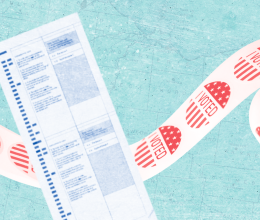This originaly appeared on Cleveland.com on Nov. 1, 2020.
CLEVELAND -- This is the first election in our lifetimes to occur during a global pandemic, and one in which an unprecedented number of voters will cast their ballots by mail. While we're accustomed to watching the results roll in live on election night, this time it may take days — possibly even weeks — to call the winners.
And that's OK. Accessibility and accuracy are far more important during a close election than immediate results.
This year, more than 3.2 million Ohio voters – and counting – have requested mail-in ballots. That's more than one-third of our state electorate. By the time this is all over, mail-in ballots in Ohio could easily triple the 2016 total.
It's a positive step for democracy that voting by mail is becoming more accessible and popular — all eligible voters should have this option. It's a secure, safe, and convenient way to cast your vote, and you can track your ballot online to ensure it's been received. But more mail-in ballots means more time for counting, because these ballots take longer to process.
Fortunately, in Ohio, election officials start “readying” mail-in ballots for counting when they are received during the early voting period. The same is true for Florida and North Carolina, among others. However, in Pennsylvania and Wisconsin, ballots cannot be opened until Election Day, meaning it could take days, or longer, before outcomes in many battleground states are determined.
As Ohio Secretary of State Frank LaRose has said, “Every vote needs to be counted that was legally cast.” The American Civil Liberties Union of Ohio couldn't agree more, especially because Ohio law allows for ballots to be received and counted up to 10 days beyond Election Day, as long as they are postmarked by Nov. 2. These votes, just like any others, are legal and, therefore, just as eligible.
This means, if the vote is close, we may not know the winners in Ohio – or nationally – on election night. Let's all get ready for that. Not knowing will be nerve-racking, but it's no reason to become conspiratorial. It should be a good sign that the process is working as designed. Each and every vote must count. We call it democracy.
That's not to say that media pundits or even the candidates themselves won't try to preemptively declare victory. But just because someone says they are the winner doesn't make it true. Election-night results alone will not tell the full story.
Some recent surveys suggest more Republicans will vote in-person, while more Democrats will vote by mail. Early results, therefore, will inevitably be skewed along partisan lines, depending if it's a state where mail-in votes are counted first versus where they are counted last. That means early blue-looking states may in time flip red, and early red-looking states could eventually turn blue. It's not concerning; it's called counting, and it's definitely no reason to deny eligible votes from being tabulated.
There are legitimate, practical reasons why mail-in ballots may slow election results. Opening envelopes and unfolding ballots mean longer processing times, and security protocols must be followed to verify each mail-in ballot, just as ballots cast in-person are subject to verification.
We should be mentally prepared for the likelihood that we may be waiting longer this year before winners are declared, and we should all dismiss any premature claims of victory. It's important to remember that we, the people, are in the driver's seat, not the politicians. We have the power, and the more of us who vote, the stronger our democracy will be, and remain, for future generations.
The goal of any democratic election is to represent the will of the people. We must count every single vote. Every Ohio voter deserves to be heard. Let's prepare for an election week – not just an Election Day – to make sure that happens.





